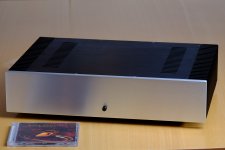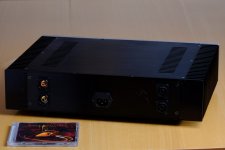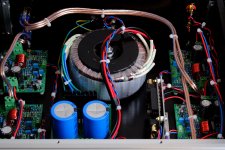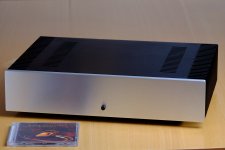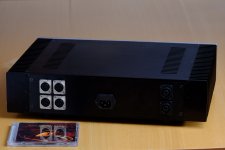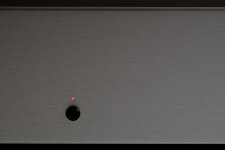It's a phrase Professor Brian cox used only yesterday. So must be good. If it offends you report me using the handy button. Otherwise look at the annihilation of the S/N ratio soong causes...
Billshurv, your pugnacious discussion style is far more obnoxious than George Soong has ever been. I find him a sincere guy, with different ideas than I hold, but a gentleman in putting them forward.
You, on the other hand, remind me of a pussy whipped guy I once knew, who habitually vented his pent up anger on strangers, untill he finally got what was coming to him.
You, on the other hand, remind me of a pussy whipped guy I once knew, who habitually vented his pent up anger on strangers, untill he finally got what was coming to him.
The only explanation of the lost shipment I can think of is incorrectly typed address. Has nothing to do with the shipping method.
In general, unless you pay for premium shipping service, shipments get lost all the time, even purely domestic ones. Certainly, international shipping is all the more complex. Go to YouTube and search for FedEx or UPS package handling videos. Or just ask around in the lounge.
In my experience, just talking domestic shipments in the USA, I've had problems at one point or another with the big three (UPS, USPS, FedEx). Although USPS is the worst by far. I just consider it a fact of life that packages get lost from time to time. When you see how the carriers handle your parcels, it's amazing stuff actually shows up in tact as often as it does.
I have never had lost mail. All pretty much received in the expected time. The second shipment Tom was careful enough to let me confirm the address on the package, and I also asked to leave a recipient contact phone number which was very useful. When shipping internationally, using a language foreign to the receiving country can cause problems. At least in Taiwan, the mailman will always call if they find the address confusing, not sure about other countries.
I have a question about the Mod 86 V1 vs V2. The Thiele network and Zobel has changed. In V1, the Thiele network is the same as the LM3886 data sheet but the Zobel is different. In V2 the Thiele is different from the data sheet, but the Zobel is the same. Is there any significant difference going either way? Or is it depending on which lot of LM3886 chips you get?
Billshurv, your pugnacious discussion style is far more obnoxious than George Soong has ever been. I find him a sincere guy, with different ideas than I hold, but a gentleman in putting them forward.
You, on the other hand, remind me of a pussy whipped guy I once knew, who habitually vented his pent up anger on strangers, untill he finally got what was coming to him.
We see lots of whipping about different issues here in Taiwan, I guess when we are focusing more on some of the traditional teachings, we learn to accept that people from all sorts of life are going to have different opinions and personalities. Trying to be active while minimizing direct confrontation is one thing we learn to do. This is the only way we are going to enjoy the benefits of diversity. The acceptance of diversity has made the U.S. the most powerful and desirable place to get an education in the world. I think that is a pretty good example.
When I see the potential some people or company have, I just have to throw in some opinions to see what happens. I have been doing this with Apple for a few years now, very little things like changing the color of the gold model on the 5s to a yellower shade. It is great to see what happens when products that I like come to market and have greater market share.
From my perspective, if I say nothing or do nothing, who knows when I will get a something that I think is really awesome. I proposed a 5.5" iPhone, and now I have it, the first iPhone I have
ever used because it is the first that meets my needs priced appropriately. Of course my recommendations always are presented with some reasoning. One would ask, why not propose to HTC which is a Taiwan brand? This is mainly because I think Apple is the only company in the world that could understand.
The Mod86 is a great accomplishment, but if the designer can only focus on limited aspects, the the potential for better overall system fidelity is limited. I think we would all like to see more advancement.
I have a question about the Mod 86 V1 vs V2. The Thiele network and Zobel has changed. In V1, the Thiele network is the same as the LM3886 data sheet but the Zobel is different. In V2 the Thiele is different from the data sheet, but the Zobel is the same. Is there any significant difference going either way? Or is it depending on which lot of LM3886 chips you get?
The Thiele and Zobel networks were optimized in Rev. 2.0 as I gained new insights into these networks and their function between Rev. 1.0 and 2.0. The values in Rev. 1.0 (and the data sheet) work well enough, but to be able to drive capacitive loads beyond 100 nF, the values in Rev. 2.0 are needed. It doesn't matter which batch of LM3886es you get.
Tom
Builds complete.
Amp #1 is for a friend of mine. He'll use it with a Sonos music player, hence, the built-in MiniDSP and RCA inputs. I used an Antek AN-2222 (200 VA) for this build.
Amp #2 is for me. I'll use it with my Focusrite Saffire PRO24 sound card and a laptop running Reaper for the crossover. The Saffire has differential out (TRS), hence my amp has XLR inputs. For this amp, I used an Antek AS-3222 (300 VA) as Antek was out of stock on the 200 VA model.
To test the thermals, I ran the two amps on one side of the chassis at 20 W output power (peak power dissipation in the LM3886) for a good hour. My math says 50 W was dissipated into the heat sink. The heat sink got 15 ºC hotter than the surrounding air and ended up at 40 ºC. For normal music reproduction, the heatsink remains cool to the touch.
15/50 = 0.3 K/W. That seems really optimistic, but that's what the math says. Note that the rest of the chassis, in particular the front panel, participates in conducting the heat away, so that may explain the stellar thermal performance.
Details on where to get the chassis are found in Post #805.
The ON indicator is an unobtrusive 1.0 mm diameter red dot. I made this using a trick I picked up from one of the guys in the Tubes forum. First a 1.0 mm hole is drilled through the front panel. Then a 5.0 mm counter bore is drilled from the inside of the front panel. The counter bore stops about 2 mm from the front face of the panel. Then an LED is glued in place using 5-minute epoxy. I use a pretty red LED (HLMP-D101). This way I end up with a nice indicator that shows the amp is on without illuminating the entire room.
I've been rocking a pair of newly built LXmini speakers with Amp #1 for a couple of days now. It's a nice combination. I'm liking it.
Tom
Amp #1 is for a friend of mine. He'll use it with a Sonos music player, hence, the built-in MiniDSP and RCA inputs. I used an Antek AN-2222 (200 VA) for this build.
Amp #2 is for me. I'll use it with my Focusrite Saffire PRO24 sound card and a laptop running Reaper for the crossover. The Saffire has differential out (TRS), hence my amp has XLR inputs. For this amp, I used an Antek AS-3222 (300 VA) as Antek was out of stock on the 200 VA model.
To test the thermals, I ran the two amps on one side of the chassis at 20 W output power (peak power dissipation in the LM3886) for a good hour. My math says 50 W was dissipated into the heat sink. The heat sink got 15 ºC hotter than the surrounding air and ended up at 40 ºC. For normal music reproduction, the heatsink remains cool to the touch.
15/50 = 0.3 K/W. That seems really optimistic, but that's what the math says. Note that the rest of the chassis, in particular the front panel, participates in conducting the heat away, so that may explain the stellar thermal performance.
Details on where to get the chassis are found in Post #805.
The ON indicator is an unobtrusive 1.0 mm diameter red dot. I made this using a trick I picked up from one of the guys in the Tubes forum. First a 1.0 mm hole is drilled through the front panel. Then a 5.0 mm counter bore is drilled from the inside of the front panel. The counter bore stops about 2 mm from the front face of the panel. Then an LED is glued in place using 5-minute epoxy. I use a pretty red LED (HLMP-D101). This way I end up with a nice indicator that shows the amp is on without illuminating the entire room.
I've been rocking a pair of newly built LXmini speakers with Amp #1 for a couple of days now. It's a nice combination. I'm liking it.
Tom
Attachments
Last edited:
Builds complete.
Amp #1 is for a friend of mine. He'll use it with a Sonos music player, hence, the built-in MiniDSP and RCA inputs. I used an Antek AN-2222 (200 VA) for this build.
Amp #2 is for me. I'll use it with my Focusrite Saffire PRO24 sound card and a laptop running Reaper for the crossover. The Saffire has differential out (TRS), hence my amp has XLR inputs. For this amp, I used an Antek AS-3222 (300 VA) as Antek was out of stock on the 200 VA model.
To test the thermals, I ran the two amps on one side of the chassis at 20 W output power (peak power dissipation in the LM3886) for a good hour. My math says 50 W was dissipated into the heat sink. The heat sink got 15 ºC hotter than the surrounding air and ended up at 40 ºC. For normal music reproduction, the heatsink remains cool to the touch.
15/50 = 0.3 K/W. That seems really optimistic, but that's what the math says. Note that the rest of the chassis, in particular the front panel, participates in conducting the heat away, so that may explain the stellar thermal performance.
Details on where to get the chassis are found in Post #805.
The ON indicator is an unobtrusive 1.0 mm diameter red dot. I made this using a trick I picked up from one of the guys in the Tubes forum. First a 1.0 mm hole is drilled through the front panel. Then a 5.0 mm counter bore is drilled from the inside of the front panel. The counter bore stops about 2 mm from the front face of the panel. Then an LED is glued in place using 5-minute epoxy. I use a pretty red LED (HLMP-D101). This way I end up with a nice indicator that shows the amp is on without illuminating the entire room.
I've been rocking a pair of newly built LXmini speakers with Amp #1 for a couple of days now. It's a nice combination. I'm liking it.
Tom
Nicely done!
Billshurv, your pugnacious discussion style is far more obnoxious than George Soong has ever been. I find him a sincere guy, with different ideas than I hold, but a gentleman in putting them forward.
You, on the other hand, remind me of a pussy whipped guy I once knew, who habitually vented his pent up anger on strangers, untill he finally got what was coming to him.
Poor choice of language for a put down there. I have no pent up anger and a lovely supportive wife currently recovering from an emergency section. she would be most offended by your accusation so lets keep it mano a mano!
What I am is frustrated at is one man completely derailing this thread with his personal views and hang ups over his local post. This is a build thread to help people who need help building their amplifiers. It is completely useless now in the form due to lounge levels of S/N. Why people cannot have the basic decency to see what the thread title is and go post guff on their own threads is beyond me. when someone does actually ask a valid question it gets lost in the noise.
Repeat: Mod-86 BUILD THREAD. NOT SOONGSC on absolute phase thread. And if he wants to modify it (which he seems hell bent on anyway) he can start his own thread for that too.
I talked about absolute polarity in this thread? Well if anyone starts talking about listening impressions... , or after I finish my built. Actually I found a polarity test track on a test CD...
Last edited:
Member
Joined 2006
Tom, I am looking forward to hearing your impression from the two sets of Lxmini using same amps but.different active xovers. 🙂
LXmini and Modulus 86
I've yet to learn how to solder but watching for every Modulus build thread I can find. I joined the club with a single parallel 86 and power 86 to get started. Kind of on the fence between using the same set up you assembled instead of parallel. That extra zero in the 1W measurement and low wattage needs of the LXmini are calling me. I'm in a condo with thin walls so 1W is all I will need unless I want to sing along. Will turn up volume loud enough to cover all that noise up. Decided to take my time and save our building from an electrical fire; should learn a little more before I jump in.
Very concerned about whether or not the recommended minidsp lives up to the quality of your amps. A hypex processing solution has been applied and great things were said. Also, I will copy your set up if it makes it easier to get the quality needed from end to end. Not a purist. It doesn't matter if a computer is added. I just want to do this right (the best way possible) the first time and be done with it for a while. Other interests deserve time too.
I too am respectfully requesting any Modulus/LXmini feedback you are willing to provide.
Thanks for all that you do!
I've yet to learn how to solder but watching for every Modulus build thread I can find. I joined the club with a single parallel 86 and power 86 to get started. Kind of on the fence between using the same set up you assembled instead of parallel. That extra zero in the 1W measurement and low wattage needs of the LXmini are calling me. I'm in a condo with thin walls so 1W is all I will need unless I want to sing along. Will turn up volume loud enough to cover all that noise up. Decided to take my time and save our building from an electrical fire; should learn a little more before I jump in.
Very concerned about whether or not the recommended minidsp lives up to the quality of your amps. A hypex processing solution has been applied and great things were said. Also, I will copy your set up if it makes it easier to get the quality needed from end to end. Not a purist. It doesn't matter if a computer is added. I just want to do this right (the best way possible) the first time and be done with it for a while. Other interests deserve time too.
I too am respectfully requesting any Modulus/LXmini feedback you are willing to provide.
Thanks for all that you do!
Atltx,
read about, build and USE a mains Bulb Tester to power ON every new mains powered project and every modified project.
This at least will save a lot of blown fuses and will eventually save a major equipment blow up.
read about, build and USE a mains Bulb Tester to power ON every new mains powered project and every modified project.
This at least will save a lot of blown fuses and will eventually save a major equipment blow up.
Atltx,
read about, build and USE a mains Bulb Tester to power ON every new mains powered project and every modified project.
This at least will save a lot of blown fuses and will eventually save a major equipment blow up.
Thanks for the info Andrew. I've read about this before and need to hear nuggets of golden advice like this frequently.
This recommendation started some years back after I asked how to check the phasing of a dual primary transformer. I already knew how to check the phasing of a dual secondary.
No Member came up with a satisfactory solution and none that guaranteed not blowing the mains fuse.
Some short while later I found out about the dim bulb and tested the idea.
From then on I have recommended it, especially since I gained more experience using it and discovered how well it works in saving damage from many different wiring faults.
No Member came up with a satisfactory solution and none that guaranteed not blowing the mains fuse.
Some short while later I found out about the dim bulb and tested the idea.
From then on I have recommended it, especially since I gained more experience using it and discovered how well it works in saving damage from many different wiring faults.
Using a Light Bulb Tester or Dim Bulb Tester (link: Powering Up Your Radio Safely With a Dim-bulb Tester) when powering up mains-powered equipment for the first time is a good recommendation. This is also useful for troubleshooting equipment that blows fuses on power-up.
That said, I actually use a variac rather than a bulb tester. Thanks to China and eBay, a 500 W variac can be had for a few bucks more than the cost of building a light bulb tester. A variac allows you to gradually increase the mains voltage to the equipment under test. When I powered up my amp for the first time, I gradually increased the mains voltage to about 20 V, measured the supply voltages, increased the mains voltage a bit more, measured the supply voltages, etc. until I had about ±15 V on the output of the Power-86. I then cranked the mains voltage to 120 V on the variac and verified the performance of the amp.
While I'm fully confident in my ability to connect everything correctly, mistakes can happen. I'd rather discover this at relatively low energy levels where a wiring mistake will result in growling from the variac and lack of supply voltage on the reservoir caps. A Big Bang test is more likely to result in spectacular fireworks in case of a wiring mistake. That's why it's called Big Bang testing...
If you don't want to build a light bulb tester and don't have a variac, at the absolute very least make sure that you have a fuse in the primary circuit of the mains transformer.
All equipment, in particular DIY equipment, should be fused. This is super easy to do with an IEC inlet that has a fuse holder built in.
Tom
That said, I actually use a variac rather than a bulb tester. Thanks to China and eBay, a 500 W variac can be had for a few bucks more than the cost of building a light bulb tester. A variac allows you to gradually increase the mains voltage to the equipment under test. When I powered up my amp for the first time, I gradually increased the mains voltage to about 20 V, measured the supply voltages, increased the mains voltage a bit more, measured the supply voltages, etc. until I had about ±15 V on the output of the Power-86. I then cranked the mains voltage to 120 V on the variac and verified the performance of the amp.
While I'm fully confident in my ability to connect everything correctly, mistakes can happen. I'd rather discover this at relatively low energy levels where a wiring mistake will result in growling from the variac and lack of supply voltage on the reservoir caps. A Big Bang test is more likely to result in spectacular fireworks in case of a wiring mistake. That's why it's called Big Bang testing...
If you don't want to build a light bulb tester and don't have a variac, at the absolute very least make sure that you have a fuse in the primary circuit of the mains transformer.
All equipment, in particular DIY equipment, should be fused. This is super easy to do with an IEC inlet that has a fuse holder built in.
Tom
Last edited:
- Home
- Amplifiers
- Chip Amps
- Modulus-86 build thread
